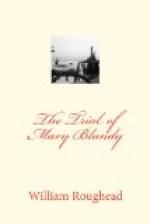morrow’s tragedy, and looked out from one of
the upper windows upon the gibbet, “opposite
the door of the gaol, and made by laying a poll across
upon the arms of two trees”—in her
case “the fatal tree” had a new and very
real significance; then she turned away, remarking
only that it was “very high.” At
nine o’clock on Monday morning, attended by Parson
Swinton, and “dress’d in a black crape
sack, with her arms and hands ty’d with black
paduasoy ribbons,” Mary Blandy was led out to
her death. About the two trees with, their ominous
“poll” a crowd of silent spectators was
assembled on the Castle Green, to whom, in accordance
with the etiquette of the day, she made her “dying
declaration”—to wit, that she was
guiltless of her father’s blood, though the
innocent cause of his death, and that she did not “in
the least contribute” to that of her mother
or of Mrs. Pocock. This she swore upon her salvation;
which only shows, says Lord Campbell, who was convinced
of her guilt, “the worthlessness of the dying
declarations of criminals, and the absurdity of the
practice of trying to induce them to confess.”
We shall not dwell upon the shocking spectacle—the
curious will find a contemporary account in the Appendix—but
one characteristic detail may be mentioned. As
she was climbing the fatal ladder, covered, for the
occasion, with black cloth, she stopped, and addressing
the celebrants of that grim ritual, “Gentlemen,”
said she, “do not hang me high, for the sake
of decency.”
Mary Blandy was but just in time to make so “genteel”
an end. That very year (1752), owing to the alarming
increase of murders, an Act was passed (25 Geo. II.
c. 37) “for better preventing the Horrid Crime
of Murder,” whereby persons condemned therefor
should be executed on the next day but one after sentence,
and their bodies be given to the Surgeons’ Company
at their Hall with a view to dissection, and also,
in the discretion of the judge, be hanged in chains.
The first person to benefit by the provisions of the
new Act did so on 1st July. But although Mary
Blandy’s body escaped these legal indignities,
as neither coffin nor hearse had been prepared for
its reception, it was carried through the crowd on
the shoulders of one of the Sheriff’s men, and
deposited for some hours in his house. There
suitable arrangements were made, and at one o’clock
in the morning of Tuesday, 7th April, 1752, the body,
by her own request, was buried in the chancel of Henley
Parish Church, between those of her father and mother,
when, notwithstanding the untimely hour, “there
was assembled the greatest concourse of people ever
known upon such an occasion.” Henley Church
has been “restored” since Mary’s
day, and there is now no indication of the grave,
which, as the present rector courteously informs the
Editor, is believed to be beneath the organ, in the
north choir aisle.




